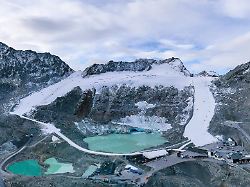Controversial start to the ski season
World Cup opener in scree desert causes a lot of trouble
October 24, 2023, 11:19 a.m
The Alpine Ski World Cup traditionally begins in Sölden at the weekend. The early start to the season is increasingly being criticized. Many ski greats think the start is at least pointless, others like downhill skier Thomas Dreßen don’t understand the criticism. The unrest is getting bigger and bigger.
A white band, largely surrounded by rubble. It’s supposed to get you excited for winter, for the start of the Alpine ski racing World Cup this weekend. The idea behind it is also to send the signal to winter sports tourists: Here we go again, come on! In fact, you might lose interest in view of the scenery on the Rettenbach glacier high above Sölden, which is no longer immune to climate change.
“The images hurt, of course, they stick in your head,” Felix Neureuther said three weeks ago, and not much has changed since then: a white band and now only slightly sugary gray slopes around it. The “brutal” effort they put into the giant slalom races (Women/Men, October 28th/29th) “I don’t think it’s worth it,” said the most successful German World Cup rider: “That has no bearing on it.”
Criticism of the early start to the World Cup season is getting louder every year. But the world association FIS is not interested in this so far – and the Austrians have their own perspective anyway. The traditional start at the end of October in Sölden, says ÖSV General Secretary Christian Scherer, “is the first strong signal of the winter and has great economic importance for the ski industry, for winter tourism and therefore for the whole of Austria.”
“That’s not logical”
Responsible athletes don’t believe in this. “What we are doing at the moment makes little sense,” says Mikaela Shiffrin, the best ski racer in the world. Colleague Lara Gut-Behrami from Switzerland also believes that the early start of the World Cup is “not logical”; for “many athletes it would make sense to start in mid-November”. Wolfgang Maier, head of sports at the German Ski Association (DSV), has also been calling for the calendar to be adjusted for years – in vain.
One incident that Greenpeace drew attention to caused a lot of trouble this year: the people of Sölden drove excavators over what the glacier had released, moving stones and rubble. For the environmentalists it was a “catastrophe”, but for the Sölden OK boss Jack Falkner it was a normal, because it was approved, process. It was about renovation work: “We are not the ones responsible. Nature does what it wants with us.”
Climate destroyer or not?
But, asks Neureuther, “do you have to dig around on the glacier so that a ski race can take place?” Thomas Dreßen may not understand the criticism. “It was,” he assures us, “maintenance work for the slopes,” which “was carried out in the spirit of the sustainability of skiing and not specifically for racing.” In fact, the slope used for the World Cup has been smoothed so that less snow has to be put there.
As a downhill specialist, Dreßen will not be at the start on the weekend; It is understandable that he, like many in the DSV, is seeking understanding for Sölden: “Sölden” is his main sponsor, and the DSV is allowed to go there for training. In general, it goes against the grain for Dreßen that his sport and he and his colleagues are constantly portrayed as climate sinners. Children who go on skiing holidays are also portrayed as “climate destroyers”: “It can’t be that.”
By the way, the slope in Sölden consists of around 45,000 cubic meters of snow, which the people of Sölden had already stored in depots in April. Of course, there are still doubts about whether their effort creates a good picture. Industry queen Shiffrin asks: “To what extent should we adapt our environment to a schedule that we want? Or should we adapt the schedules to the environment?”
